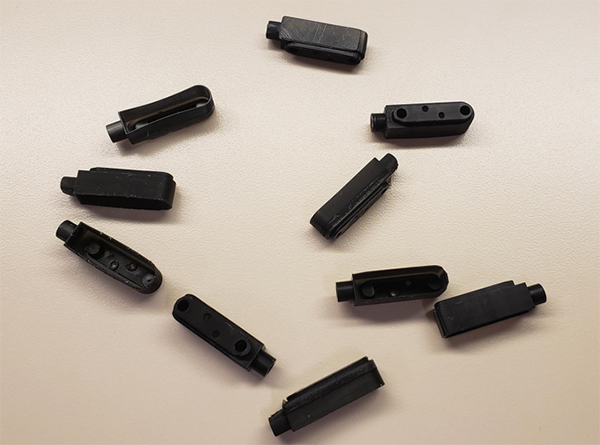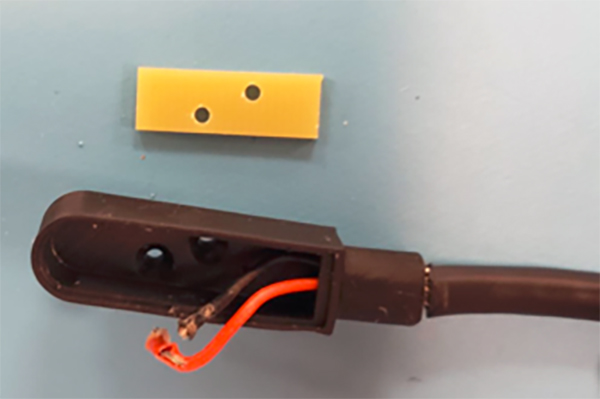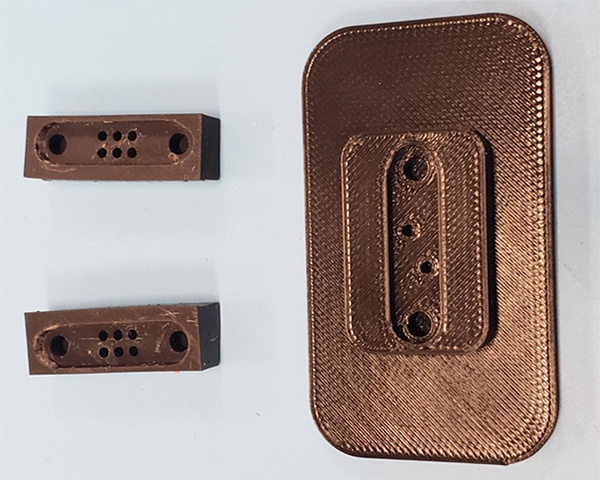Using 3D Printing to Build Overmolded Cables During a Shutdown
Challenge
Epec was approached by a new customer that required a custom overmolded cable for a new product line. The launch was in a few short weeks, and this customer needed to find a supplier that could assemble 50 to 100 cables quickly while also supporting their expected production volumes of several thousand assemblies per year. Unfortunately, the request for quote was received the week that our production sites in Asia commenced their annual Lunar New Year shutdown. This would impact production deliveries for several weeks and threaten our customer’s looming product launch schedule.
On one end of the cable was an ordinary male USB-A connector with a standard overmold, a simple solution that Epec supports frequently. On the other end was a custom charging adapter with spring-loaded pins, neodymium magnets, and a tight tolerance plastic keyway feature. The custom-end with the pins and magnets was quote small at 30mm long and 8mm wide, further complicating the assembly steps. Adding magnets and spring-loaded pins to an overmolded cable is very common, but a design this small would certainly pose some unexpected challenges.
The customer needed 50 pieces in 3 weeks or less. Epec decided to 3D print the shells and assemble them with RTV potting and super glue. All RTV potting and adhesive were readily available and chosen because they would do the job and were in stock within the required timeline.

3D printed shells built using Resin Printer.
We needed to measure the outer diameter of the cable to properly fit the 3D print shells. With no data sheet available for the off-the-shelf USB-A cable, we needed to wait until we had the cables in our possession to measure the wire jacket diameter. Then, we could finalize the design of the 3D-printed shells. This delayed the start of our initial 3D prints.
We didn’t have time to source and order all components and meet the customer’s timeline. Thankfully, the customer had already ordered the spring-loaded pins and magnets. Epec was able to start assembly the day we were awarded because our customer went ahead and bought the hard-to-find items already.
Solution
The neodymium magnets’ polarity was not marked. Using another magnet with known north-south poles, Epec built a fixture to help align the required neodymium magnets for installation. Once the magnets’ orientation was known, a small bead of super glue was applied to secure the magnets within the 3D-printed shell. After assembly, one of the Engineers used a smartphone compass app to verify the installation was correct.
We struggled to solder the wire to the spring-loaded pin. Epec was able to perform quick solder tests at the quote stage to assess the feasibility of soldering directly to the spring-loaded pins. These tests helped Epec confirm the heat levels and solder type were sufficient and that this build was indeed manufacturable. However, when Epec tried to solder within the 3D-printed shell, there were concerns that the heat from the soldering iron could damage the shell. Additionally, the pins were quite small requiring delicate and careful assembly techniques.

FR4 backer was used as a job aid to solder the spring-loaded pins.
To solve this, Epec designed and fabricated a small alignment tool made from spare FR4 material. We created a quick route and drill program file to quickly cut the blank FR4 down to the shapes we needed to support assembly. About a dozen FR4 backers were fabricated as temporary fixtures to complete the build.
Once a few parts were completely assembled and the process was dialed in, it was clear that this build needed some dedicated assembly tooling to help the assemblers. There were several critical steps that required the 3D-printed shell and pins to be secured while being soldered and then again while the RTV potting was applied.
Designing an assembly jig was simple since Epec already had 3D models for all components. Creating the design in SolidWorks was fast and prototype fixtures were able to be printed the next day.

3D printed assembly fixtures.
Result
For the final acceptance test, Epec developed a clever way to determine if the cable was functional. Epec engineers plugged the male USB connector into an ordinary company laptop computer to energize the cable with +5VDC. Then, Epec built a set of contact plates with each soldered to a wired lead. These leads were connectorized and then plugged directly into a handheld multimeter. This was the multimeter was able to measure the voltage across the two pins, and a positive +5VDC would indicate that the polarity was correct, and the cable was functional.
During the build, the team observed small amounts of glue and potting that accumulated around the lid where it joins the other sections of the 3D-printed shell. Photos were shared with the customer; it was confirmed that no residue shall remain in this region. The customer had concerns that too much build-up could jeopardize the tight tolerance fit of the mating assembly. As a result, Epec implemented additional cleaning steps to prevent any material build-ups and make sure the mating assembly properly fit.
This project was a success. Epec built and shipped all 50 pieces to the customer before their hard-tooled plastic parts arrived. This helped Epec meet the customer’s delivery expectations for their urgent timeline and ensured that the cable assemblies never became a pacing item impacting their critical path.
Epec was then able to offer a high production volume build to be produced offshore using dedicated overmold tooling. Epec is looking forward to working with this customer in the future and participating in future higher-volume builds.
Looking For An Overmolded Cable Assembly Solution?
From design to production, our team of experienced engineers at Epec is here to help you design a production ready overmolded cable assembly for your application.
Request a Quote Request Design Support

